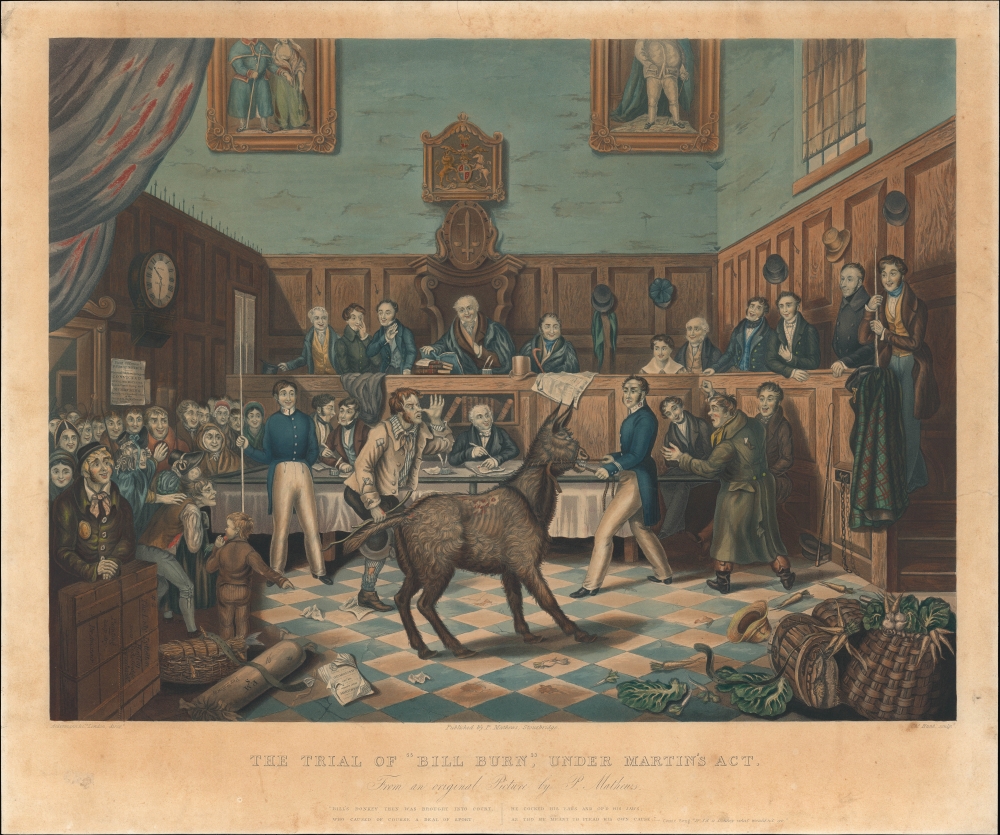1840 Ackermann Satirical Print, Trial of Bill Burns, Animal Rights
DonkeyTrial-ackermann-1840
Title
1840 (undated) 20 x 24 in (50.8 x 60.96 cm)
Description
A Closer Look
A raucous courtroom scene is depicted with an amused group of onlookers observing a stern man leading a donkey, who is being taunted by the donkey's owner, before the magistrate. The scene represents the trial of Bill Burns (here barely anonymized as 'Bill Burn'), a significant case in the early history of the animal rights movement. Burns, who had publicly and severely beaten his donkey in London, was the first person tried after the passage of Martin's Act, named after Member of Parliament Richard Martin, who is the man leading the donkey here. Martin's court room stunt was ridiculed, but worked to convince the magistrate to convict Burns.As with Martin's wider crusade for animal rights, most commentators saw the trial as amusing rather than inspiring, reflected in the expressions of most of the people in the courtroom. The case was a frequent topic of discussion and mockery in London's press and popular culture at the time, including the 'comic song' written at bottom.
Richard Martin and the Burns Trial
Martin was born to an Anglo-Irish family in County Gallway. He studied at Cambridge and went into law, becoming the High Sherrif of Galway. He served intermittently in the Irish House of Commons from 1776 and then joined the British Parliament following the Act of Union. In the British Parliament, Martin advocated for Catholic emancipation and the abolition of slavery, in addition to laws against animal cruelty. After failing the previous year, he succeeded in persuading fellow MPs to vote for the 1822 Cruel Treatment of Cattle Act (popularly known Martin's Act), which was broader in scope than the title might suggest.Not long after the Burns trial, Martin was involved in the founding of the Society for the Prevention of Cruelty to Animals and he continued to campaign for animal rights, despite being a frequent butt of jokes in the press. Martin's later life is less illustrious, as he had to flee Britain to avoid arrest for gambling debts. But his cause lived on, with additional laws against animal cruelty passed by Parliament in subsequent years and decades.
Publication History and Census
This satirical print was engraved by Charles Hunt, overseen by Ackermann and Co., and is based on an 'original picture' by P. Mathews in Stourbridge, who also published it. Nothing is known of Mathews aside from this print, but Hunt and Ackermann were active in the London publishing world at the time. Its only known institutional holding is with the Victoria and Albert Museum.CartographerS
Ackermann (1795 - 199x) was a British publishing firm founded by Rudolph Ackermann (April 20, 1764 - March 30, 1834). First known as R. Ackermann and Company, Ackermann's three sons took over the business when their father retired. The firm was known as A. Ackermann and Son in the early 20th century and had offices in London, Paris, New York, and Chicago. Their New York office was exceptionally prolific, issuing work for both the private and government sectors. Ackermann was acquired in late 1990s and the imprint resurrected. More by this mapmaker...
Charles Hunt (1803 – 1877) was a London-based etcher and engraver, including of aquatints. He is best known for his engravings related to sporting events, such as horseracing and hunting, though he also produced satirical prints and works in other genres. He went into business with George Hunt, likely his cousin, and found great success initially, but later went bankrupt twice. Learn More...

